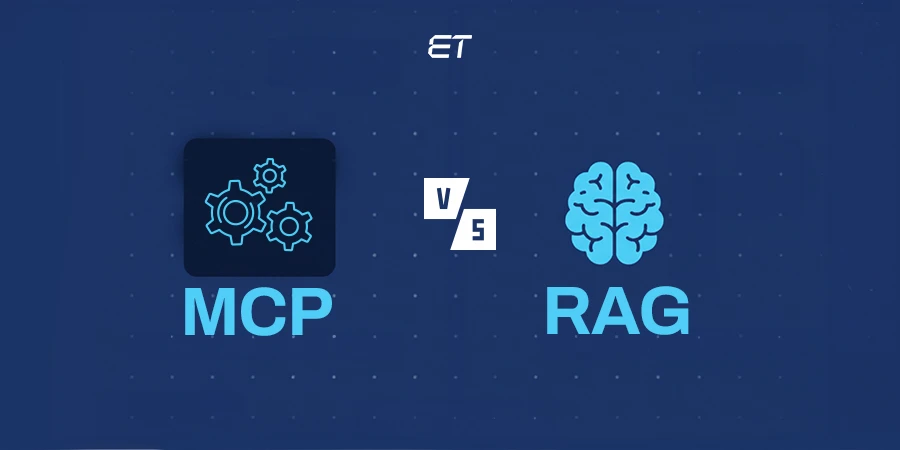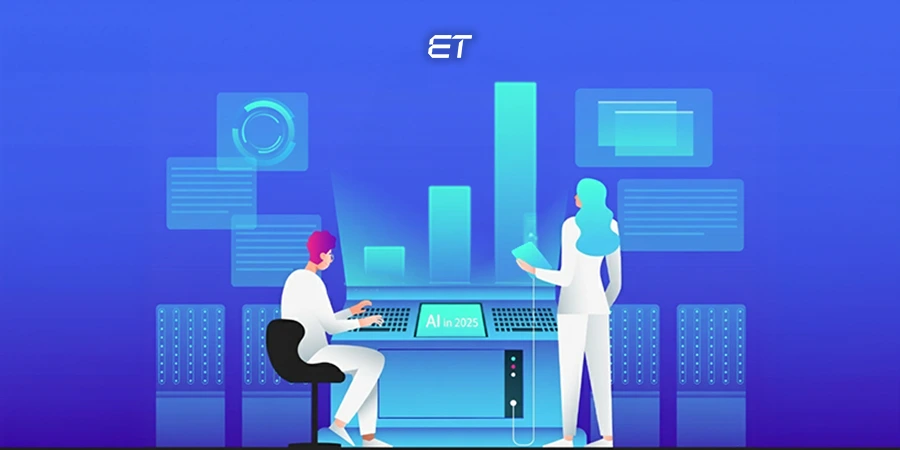
Understanding the Types of AI for Enterprise Transformation
Artificial Intelligence is no longer at the doorstep of enterprises; it is already integrated and reshaping how industries operate. In 2026, the European Union committed $1.1 billion to accelerate the adoption of AI across healthcare, manufacturing, and the energy sector.
The message is clear: AI is not a single technology, but a dynamic ecosystem, a connected network of technologies, data, human expertise, and processes that drive innovation, efficiency, and strategic growth.
This top-down momentum is mirrored at the individual level, where 40% of U.S. employees already rely on AI tools at work, which makes the technology central to productivity and decision-making.
Yet, the question remains: what type of AI are we actually referring to?
The AI-driven recommendations differ significantly from the intelligence behind autonomous vehicles, medical diagnostics, or generative design. Understanding these types of AI is critical for enterprises, as each offers unique capabilities, limitations, and business value.
AI is often used as a blanket term, but in practice, it ranges from Reactive AI, which responds to input, interprets emotions, and considers context. For enterprises, recognizing these different types of AI is vital to matching the right intelligence, challenge, and adapting.
Why Artificial Intelligence is the Key to Enterprise Growth and Decision Automation
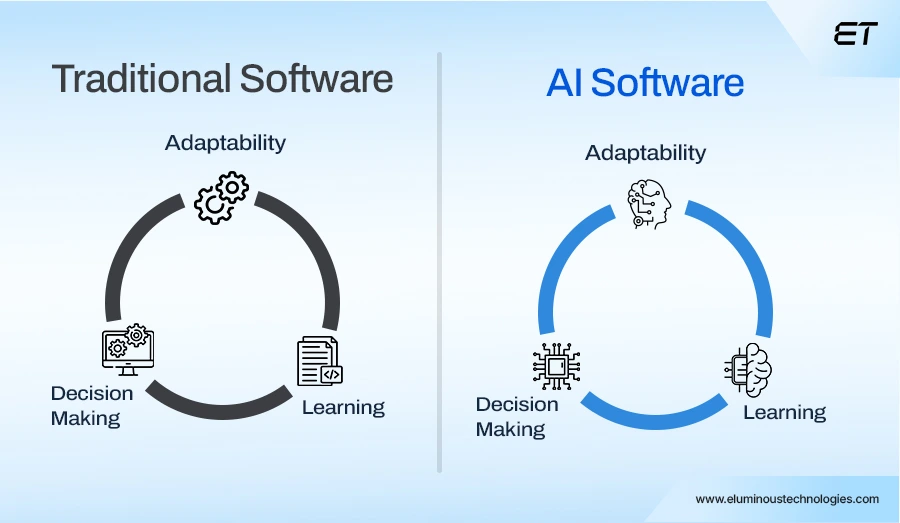
Artificial Intelligence (AI) is the strategic application of computational technologies designed to automate processes, enhance decision-making, and drive enterprise-wide intelligence. As John McCarthy, one of the leaders of AI, famously defined it: “AI is the science and engineering of making intelligent machines.”
This capacity for continuous learning and adaptation is AI’s key differentiator, which allows systems to improve decision-making over time and is a competitive imperative for modern enterprises.
Enterprises today rely heavily on AI to stay competitive. For example, Google’s voice recognition and search ranking systems process billions of queries daily. On Netflix’s platform, around 80 % of streamed content is discovered through its AI-driven recommendation engine.
Meanwhile, autonomous vehicles equipped with LiDAR and sensor arrays generate up to 1.3 million data points per second, enabling real-time perception and control.
In short, AI has evolved from a futuristic concept to an essential enterprise utility for transforming operations, reshaping customer experiences, and opening up entirely new growth opportunities.
AI-driven systems are only as strong as their precision and reliability. Explore how leading enterprises ensure accuracy and performance in every AI deployment.
What are the Different Types of AI
Artificial Intelligence (AI) is not a single invention but a spectrum of systems, each with different scopes of intelligence, limitations, and potential.
One of the most effective ways to understand AI’s growth is by classifying it based on capabilities, that is, how advanced and adaptable the intelligence is.
This framework categorizes three main types of AI: Narrow AI, General AI, and Superintelligent AI.
Narrow AI (Weak AI) – The AI of Today

Narrow AI, also known as Weak AI, is the most common and practical form of artificial intelligence currently in existence. It is called “narrow” because it is designed to perform a single, domain-specific task extremely well, but it lacks the ability to generalize its intelligence outside that scope.
Andrew Ng, a leading AI researcher, once said: “If a typical person can do a mental task with less than one second of thought, we can probably automate it using AI.” This is exactly where Narrow AI excels.
Key Characteristics of Narrow AI:
- Task-specific intelligence
Narrow AI is trained to perform one particular function extremely well, such as detecting fraud in financial transactions or recommending the next show on Netflix. However, it cannot step outside this defined purpose. A fraud-detection system cannot suddenly compose music or diagnose a medical scan.
- Driven by massive datasets:
These systems rely heavily on vast amounts of labeled or unlabeled data to learn patterns. For example, Google Translate was trained on billions of sentence pairs to understand cross-lingual mapping. Without such domain-specific data, Narrow AI cannot function effectively.
- Powerful algorithms behind the scenes:
Architectures like Convolutional Neural Networks (CNNs) are widely used for image processing, while Transformers (BERT, GPT, LLaMA) natural language processing. These models learn intricate patterns but lack any contextual awareness outside the training set.
- Non-transferable knowledge:
Perhaps the biggest limitation of Narrow AI is its inability to transfer skills. DeepMind’s AlphaGo is a legendary system that beat human champions in the game of Go, yet it cannot play chess or even apply its intelligence to other strategy games. Each new domain requires an entirely separate system.
For enterprises, this means AI solutions must still be purpose-built. It delivers deep efficiency within defined boundaries, but does not yet offer the cross-domain intelligence needed for full-scale business transformation.
General AI (Strong AI): The Human-Level Horizon

General AI, or Strong AI, represents the next frontier: machines that can match human intelligence across domains. Unlike Narrow AI, which is task-bound, General AI offers memory flexibility, the ability to learn new skills, reason logically, and adapt in unfamiliar scenarios without requiring retraining.
Imagine an AI that can not only write a business strategy report but also shift seamlessly to diagnosing a patient’s illness, planning a city’s traffic flow, or composing a symphony, all with one system. That is the vision of General AI.
What Sets General AI Apart?
- Cross-domain adaptability:
Unlike Narrow AI, which is locked to one task, General AI would apply knowledge across vastly different fields. For example, it could use medical reasoning to analyze a new outbreak while also applying financial logic to predict economic effects.
- Human-like reasoning and common sense:
A key requirement for General AI is the ability to perform logical reasoning beyond raw data patterns. Humans naturally know that “ice melts in the sun,” but today’s AI models do not unless explicitly trained. Embedding such common sense remains one of the greatest technical challenges.
- Learning without retraining:
Current AIs must be retrained on new datasets for every new domain. General AI, in contrast, would continuously learn, just like humans do, adapting to new problems without needing to start over.
At present, no true General AI exists. Even the most advanced LLMs are still fundamentally Narrow AI, impressive but limited to what they have been trained on.
Superintelligent AI: The Hypothetical Leap Beyond Humanity

Superintelligent AI represents the most ambitious and unsettling vision of the future. It describes a stage where machines could go beyond human intelligence in every domain, from scientific discovery to creative problem-solving. While the potential for innovation is boundless, it also presents challenges related to control, ethics, and intelligence itself.
As philosopher Nick Bostrom argued in his landmark book Superintelligence: “Once AI reaches the human level, there is no reason it would stop there.”
Potential Capabilities of Superintelligence:
Superintelligent AI remains a theoretical concept, but the possibilities it represents continue to capture the world’s imagination.
Revolutionary scientific breakthroughs:
In theory, a superintelligent system could uncover cures for complex diseases, design clean energy technologies, or solve long-standing mysteries in physics. The kind of discoveries that might take humans decades could, one day, happen in moments.
Strategic global problem-solving:
Imagine an AI capable of analyzing global data and running endless simulations in real time. It could identify smarter ways to tackle climate change, manage planetary resources, or even ease geopolitical conflicts through optimized decision models.
Innovation at scale:
Superintelligence could push innovation into entirely new territory by creating technologies and solutions that humans have not yet imagined, advancing industries and societies faster than ever before.
All of this remains speculative. We are nowhere near building such systems, and even the idea brings serious ethical and governance questions.
They remind enterprises and policymakers that while superintelligence may be a distant vision, the foundations for responsible, transparent, and ethical AI must be built today, before imagination turns into reality.
Translating AI potential into real enterprise impact remains the challenge. Learn how organizations are scaling responsibly with measurable outcomes.
Classifying Types of AI by Function
While AI can be categorized by capability (how intelligent it is), another critical lens is its functionality, that is, what kind of tasks it performs and how it interacts with data and environments.
This classification traces the evolution of AI systems from simple rule-followers to theoretically self-aware entities.
The four key functional categories are: Reactive Machines, Limited Memory, Theory of Mind, and Self-Aware AI.
1. Reactive Machines
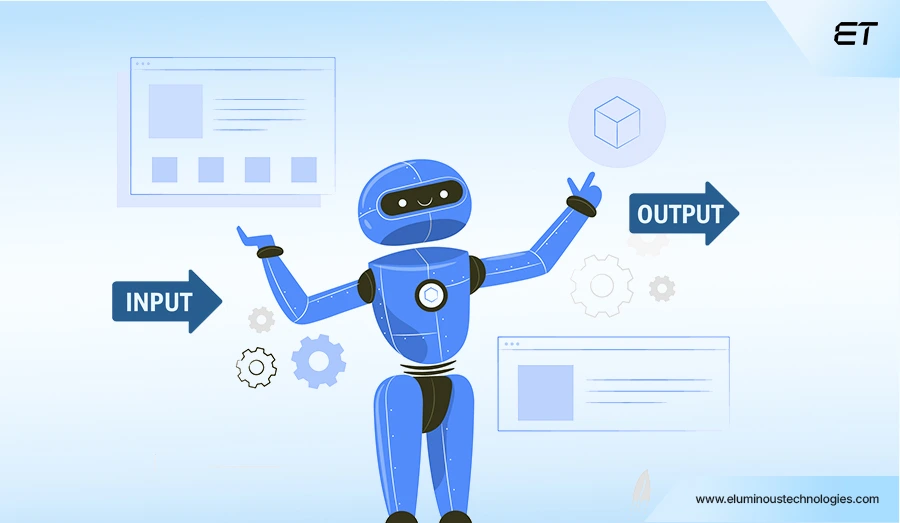
Reactive machines are the earliest and most basic form of AI. They don’t learn or remember; instead, they only respond to inputs with predefined outputs.
- Stateless: Work only on current inputs, with no memory of past data.
- No learning: Cannot improve performance over time.
- Rule-based: Operates entirely on hardcoded rules.
Reactive machines are extremely rigid and cannot adapt or handle new situations.
2. Limited Memory AI

Limited Memory AI can use historical data and short-term memory to improve decision-making. Most modern AI systems fall into this category.
- Short-term recall: Stores data temporarily to recognize trends and patterns.
- Learning-enabled: Continuously updates with new data (e.g., fraud detection, self-driving cars).
- Tech foundation: Built on LSTM, reinforcement learning, and supervised learning.
Despite its adaptability, Limited Memory AI has a limited memory and lacks continuous, long-term understanding of the world.
3. Theory of Mind AI

A research-stage AI aiming to understand human emotions, intentions, and beliefs to enable socially intelligent interaction.
- Emotion-aware: Identifies cues from voice, facial expressions, and gestures.
- Intent-driven: Goes beyond commands to infer the user’s underlying goals.
- Contextual: Engages in natural, adaptive, human-like conversations.
While significant progress has been made, Theory of Mind AI remains an experimental technology. Current systems can simulate empathy and understanding, but do not possess genuine emotional comprehension or consciousness.
4. Self-Aware AI – The Hypothetical Frontier
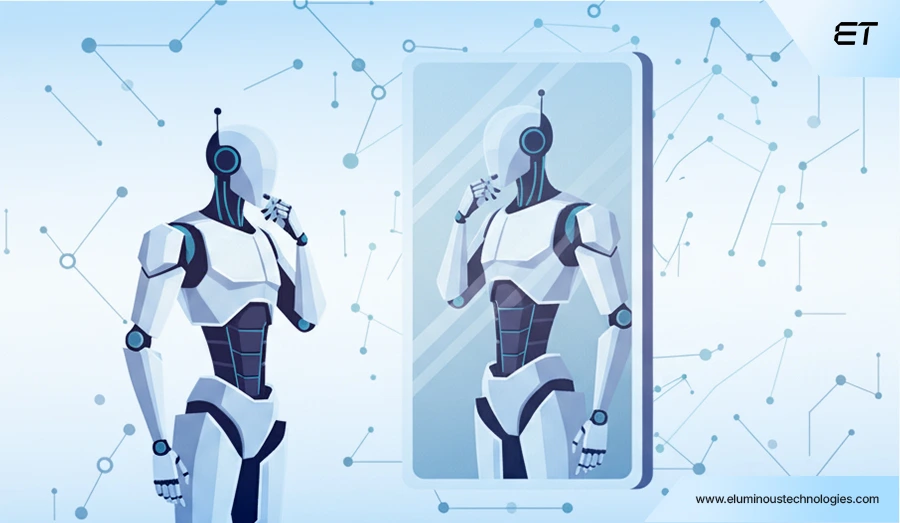
The most advanced, and currently entirely theoretical, stage of AI is a system with a sense of consciousness, self-awareness, and independently defined goals.
This concept represents the farthest boundary of artificial intelligence research, where machines could, in theory, reflect on their own state and intentions.
- Self-aware cognition: Recognizes its own status, identity, and operational objectives.
- Autonomous decisions: Has the capacity to establish and pursue goals without direct human programming.
- Creative intelligence: Demonstrates the ability to generate original ideas or solutions, extending beyond pre-defined algorithms.
Currently, Self-Aware AI remains a conceptual construct, as there is no evidence or scientific framework to prove that machines can attain true consciousness. Yet, this horizon matters.
It shapes ongoing debates around AI ethics and governance, urging enterprises to build responsible systems long before such possibilities ever emerge.
Main Types of AI Technologies Transforming Industries
From healthcare to finance, businesses are using various types of AI technologies to automate processes, enhance decision-making, and develop entirely new solutions.
Below are some of the core AI technologies shaping the present and future.
| AI Technology | Core Function | Key Examples | Impact Area |
| Machine Learning (ML) | Learns patterns from data | Fraud detection, demand forecasting | Finance, Retail |
| Deep Learning (DL) | Multi-layer neural networks for complex tasks | Image recognition, speech-to-text | Healthcare, Vision AI |
| Natural Language Processing (NLP) | Understands & generates human language | ChatGPT, Google Translate | Customer service, Content |
| Computer Vision | Interprets images & video | Face ID, autonomous vehicles | Security, Mobility |
| Robotics & RPA | Automates physical & digital tasks | Boston Dynamics robots, UiPath | Manufacturing, Business Ops |
| Generative AI | Creates new content from data | DALL·E, MidJourney | Marketing, Design, Media |
Why the Types of AI Matter for the Future of Enterprises
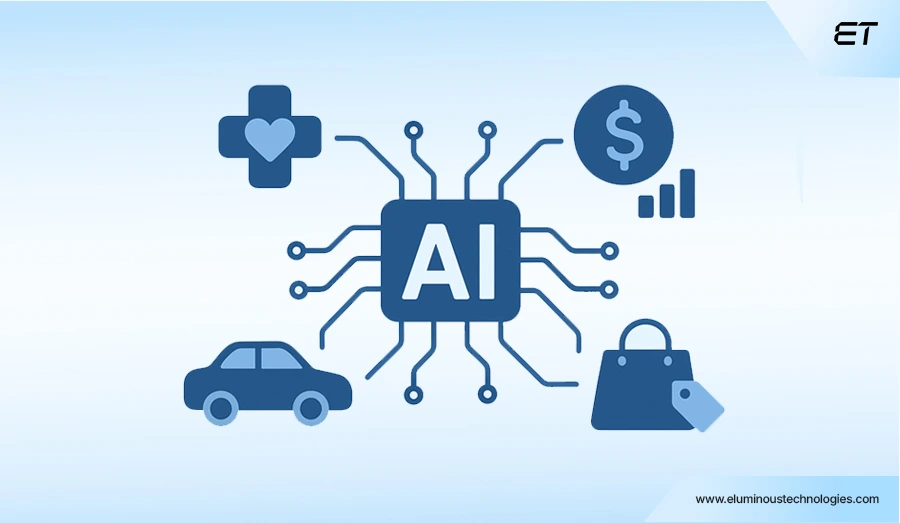
The various types of AI have a significant impact on how enterprises can innovate, scale, and remain competitive in the digital-first economy.
For example, machine learning models already power fraud detection in banks like JPMorgan Chase, preventing billions in annual losses, while computer vision systems help manufacturers like BMW achieve near-zero defect assembly lines through real-time quality inspection.
This shows why selecting the right AI type is crucial: a retailer may rely on NLP for personalized chatbots, while a logistics company uses reinforcement learning for route optimization.
In the future, enterprises will strategically integrate multiple forms of AI by combining predictive intelligence with generative capabilities to create more adaptive, insight-driven systems.
Rather than a dividing line between leaders and laggards, the understanding and responsible adoption of diverse types of AI will define how organizations innovate. It will also determine how they sustain long-term relevance in a changing digital economy.
Wrapping Up
The path to enterprise transformation is no longer a question of if you will adopt AI, but which AI you will master. We have moved far beyond AI as a futuristic concept. The true strategic challenge lies in understanding the difference between a Reactive Machine that simply follows rules and a Limited-Memory AI.
Your business challenges are unique, and your AI solution should be too. Don’t settle for a one-size tool. The key intelligence to consider is whether to opt for custom GenAI, full-stack development, or a specialized machine learning model, as each can convert your data into a market advantage.
As enterprises continue to explore the transformative potential of AI, success will depend on turning strategy into scalable, intelligent solutions.
With proven expertise in AI software development, eLuminous Technologies helps organizations bridge this gap by delivering custom software solutions that align technology with their business vision.
Partner with a team that blends AI innovation with strategic insight to help your enterprise build lasting intelligence.

